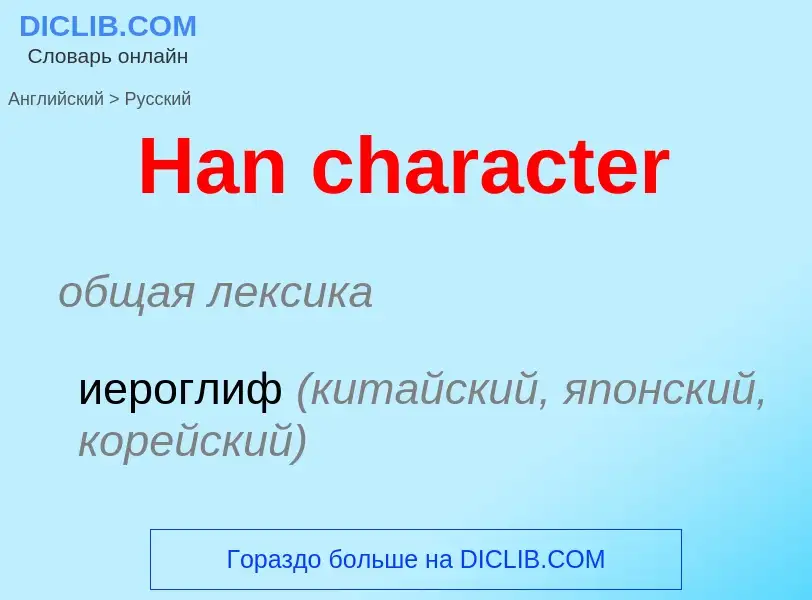Tradução e análise de palavras por inteligência artificial ChatGPT
Nesta página você pode obter uma análise detalhada de uma palavra ou frase, produzida usando a melhor tecnologia de inteligência artificial até o momento:
- como a palavra é usada
- frequência de uso
- é usado com mais frequência na fala oral ou escrita
- opções de tradução de palavras
- exemplos de uso (várias frases com tradução)
- etimologia
Han character - tradução para Inglês
общая лексика
китайские иероглифы
Wikipédia
Chinese characters are logograms developed for the writing of Chinese. Chinese characters are the oldest continuously used system of writing in the world. By virtue of their widespread current use throughout East Asia and Southeast Asia, as well as their profound historic use throughout the Sinosphere, Chinese characters are among the most widely adopted writing systems in the world by number of users.
The total number of Chinese characters ever to appear in a dictionary is in the tens of thousands, though most are graphic variants, were used historically and passed out of use, or are of a specialized nature. A college graduate who is literate in written Chinese knows between three and four thousand characters, though more are required for specialized fields. In Japan, 2,136 are taught through secondary school (the Jōyō kanji); hundreds more are in everyday use. Due to separate simplifications of characters in Japan and in China, the kanji used in Japan today has some differences from Chinese simplified characters in several respects. There are various national standard lists of characters, forms, and pronunciations. Simplified forms of certain characters are used in mainland China, Singapore, and Malaysia; traditional characters are used in Taiwan, Hong Kong, Macau. In addition, chinese characters have been adapted to write other East Asian languages, and remain a key component of the Japanese writing system where they are known as kanji. Chinese characters in South Korea, which are known as hanja, retain significant use in Korean academia to study its documents, history, literature and records. Vietnam once used the chữ Hán and developed chữ Nôm to write Vietnamese before turning to a romanized alphabet. In Japan, common characters are often written in post-Tōyō kanji simplified forms, while uncommon characters are written in Japanese traditional forms. During the 1970s, Singapore had also briefly enacted its own simplification campaign, but eventually streamlined its simplification to be uniform with mainland China.
In modern Chinese, most words are compounds written with two or more characters. Unlike alphabetic writing systems, in which the unit character roughly corresponds to one phoneme, the Chinese writing system associates each logogram with an entire syllable, and thus may be compared in some aspects to a syllabary. A character almost always corresponds to a single syllable that is also a morpheme. However, there are a few exceptions to this general correspondence, including bisyllabic morphemes (written with two characters), bimorphemic syllables (written with two characters) and cases where a single character represents a polysyllabic word or phrase.
Modern Chinese has many homophones; thus the same spoken syllable may be represented by one of many characters, depending on meaning. A particular character may also have a range of meanings, or sometimes quite distinct meanings, which might have different pronunciations. Cognates in the several varieties of Chinese are generally written with the same character. In other languages, most significantly in modern Japanese and sometimes in Korean, characters are used to represent Chinese loanwords or to represent native words independent of the Chinese pronunciation (e.g., kun'yomi in Japanese). Some characters retained their phonetic elements based on their pronunciation in a historical variety of Chinese from which they were acquired. These foreign adaptations of Chinese pronunciation are known as Sino-Xenic pronunciations and have been useful in the reconstruction of Middle Chinese.






![Yellow}}: Chinese characters were once used officially, but this is now obsolete ([[Mongolia]], [[North Korea]], [[Vietnam]]) Yellow}}: Chinese characters were once used officially, but this is now obsolete ([[Mongolia]], [[North Korea]], [[Vietnam]])](https://commons.wikimedia.org/wiki/Special:FilePath/Map-Chinese Characters.png?width=200)

![Mongolian text from ''[[The Secret History of the Mongols]]'' in Chinese transcription, with a glossary on the right of each row Mongolian text from ''[[The Secret History of the Mongols]]'' in Chinese transcription, with a glossary on the right of each row](https://commons.wikimedia.org/wiki/Special:FilePath/Secret history.jpg?width=200)

![Mifu]]. For centuries, the Chinese literati were expected to master the art of calligraphy. Mifu]]. For centuries, the Chinese literati were expected to master the art of calligraphy.](https://commons.wikimedia.org/wiki/Special:FilePath/This Letter written by Mi Fei.jpg?width=200)
![Sample of the cursive script by Chinese [[Tang dynasty]] calligrapher [[Sun Guoting]], c. 650 AD Sample of the cursive script by Chinese [[Tang dynasty]] calligrapher [[Sun Guoting]], c. 650 AD](https://commons.wikimedia.org/wiki/Special:FilePath/Treatise On Calligraphy.jpg?width=200)

![A page from a [[Song dynasty]] publication in a [[regular script]] typeface which resembles the handwriting of [[Ouyang Xun]] from Tang Dynasty A page from a [[Song dynasty]] publication in a [[regular script]] typeface which resembles the handwriting of [[Ouyang Xun]] from Tang Dynasty](https://commons.wikimedia.org/wiki/Special:FilePath/浙江姓解1.jpeg?width=200)
